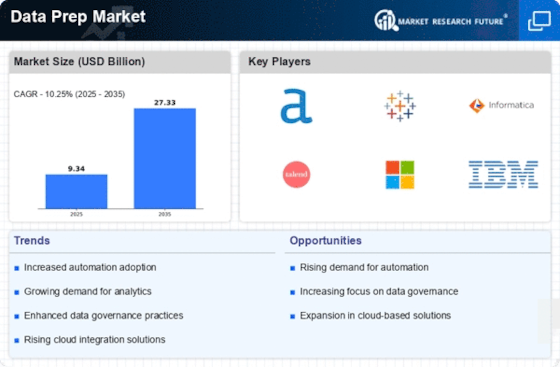Growth of Big Data Technologies
The rapid expansion of big data technologies is significantly influencing the Data Prep Market. With the volume of data generated daily reaching unprecedented levels, organizations are compelled to adopt robust data preparation solutions to manage and analyze this influx. The market for big data analytics is projected to grow at a compound annual growth rate of over 10 percent in the coming years. This growth is driving the demand for data preparation tools that can efficiently handle large datasets, ensuring that businesses can derive actionable insights from their data. Consequently, the Data Prep Market is witnessing innovations aimed at enhancing data processing capabilities, thereby enabling organizations to harness the full potential of big data.
Adoption of Cloud-Based Data Solutions
The shift towards cloud-based data solutions is significantly impacting the Data Prep Market. Organizations are increasingly migrating their data operations to the cloud to benefit from scalability, flexibility, and cost-effectiveness. The cloud data preparation market is expected to witness substantial growth, with estimates suggesting a rise of over 15 percent annually. This transition is driving the demand for cloud-native data preparation tools that can seamlessly integrate with existing cloud infrastructures. As businesses seek to optimize their data workflows in the cloud, the Data Prep Market is responding with innovative solutions that facilitate real-time data processing and collaboration. This trend is likely to continue as more organizations recognize the advantages of cloud-based data management.
Rising Demand for Data-Driven Decision Making
The increasing emphasis on data-driven decision making is a primary driver in the Data Prep Market. Organizations are recognizing the value of data analytics in enhancing operational efficiency and strategic planning. According to recent statistics, companies that leverage data analytics are 5 times more likely to make faster decisions than their competitors. This trend is prompting businesses to invest in data preparation tools that facilitate the extraction, transformation, and loading of data. As a result, the Data Prep Market is experiencing a surge in demand for solutions that streamline data workflows and improve data quality. The need for timely and accurate data is becoming paramount, leading to a proliferation of data preparation solutions that cater to diverse business needs.
Increased Focus on Data Quality and Governance
The heightened focus on data quality and governance is emerging as a crucial driver in the Data Prep Market. Organizations are increasingly aware of the risks associated with poor data quality, which can lead to erroneous insights and decision-making. As a result, there is a growing demand for data preparation solutions that incorporate data cleansing and validation features. Research indicates that companies with strong data governance frameworks are 2.5 times more likely to achieve their business objectives. This trend is prompting investments in data preparation tools that not only enhance data quality but also ensure compliance with regulatory standards. The Data Prep Market is thus evolving to meet these needs, offering solutions that prioritize data integrity and governance.
Emergence of Self-Service Data Preparation Tools
The emergence of self-service data preparation tools is reshaping the Data Prep Market. These tools empower business users to prepare and analyze data without relying heavily on IT departments, thereby accelerating the data preparation process. The self-service analytics market is projected to grow significantly, with many organizations adopting these tools to enhance productivity and reduce bottlenecks. This trend is indicative of a broader shift towards democratizing data access within organizations. As a result, the Data Prep Market is witnessing a proliferation of user-friendly data preparation solutions that cater to non-technical users. This democratization of data preparation is likely to enhance overall data literacy and foster a data-driven culture within organizations.

















Leave a Comment